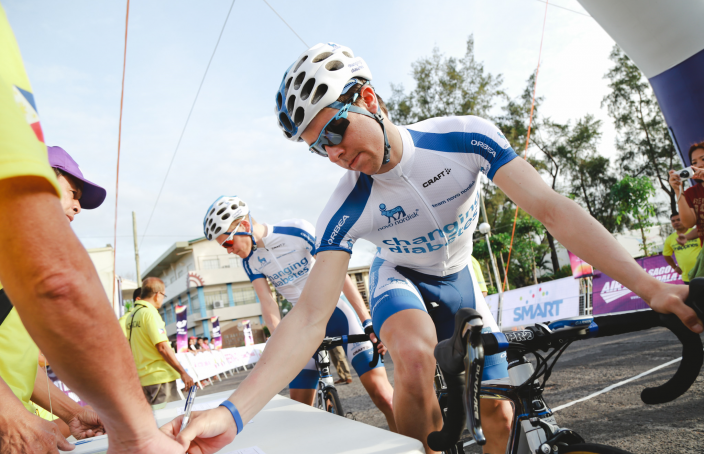Stephen Clancy, a professional cyclist born in Limerick, Ireland races for Team Novo Nordisk, but considers his type 1 diabetes just “one extra thing to think about.”
The 22-year-old was diagnosed three years ago at the age of 19, when routine blood tests indicated abnormally high blood sugar levels. Stephen was told by a diabetes consultant that continuing with a cycling career could complicate his diabetes management.
His dedication unwavering, Stephen signed with Team Novo Nordisk six months later, the world’s first all-diabetes professional cycling team, and his accomplishments already include being named Cycling Ireland’s “Domestic Rider of the Year”.
Diabetes.co.uk spoke with Stephen about his type 1 diabetes, how he controls his condition when cycling and what he has learned along the way to improve his diabetes management.
Q. What ran through your mind when you were diagnosed with type 1 diabetes?
“The first thing I thought about was whether or not I could still have a career in the sport. I was told was that extreme levels of exercise could complicate my diabetes management – that diabetes was already difficult enough to manage without trying to combine it with vigorous activity. I was advised just to cycle a mile at a time, so I certainly wasn’t too optimistic about my future on two wheels. Thankfully, within 24 hours of my diagnosis, I remembered watching Team Type 1 (the predecessor to Team Novo Nordisk) racing on TV and immediately I was inspired not to let diabetes get in the way of my dreams.”
Q. How do the challenges of diabetes impact cycling at such a high level?
“Having diabetes is just one extra thing I have to think about while racing. I need to ensure I have all the necessary supplies with me at all times. Keeping my blood glucose levels in the optimum zone is one of the biggest tasks. This means checking my blood glucose regularly and making adjustments to ensure I stay within the target range. I diligently watch what I eat, closely count carbohydrate intake, monitor activity levels and predict blood glucose level trends along with taking my insulin. It’s certainly not impossible. I like to see these changes as challenges that can be overcome rather than barriers.”
Q. How were you able to develop medication routines for training and races?
“I don’t have one set medication routine that I stick to because every day changes slightly. Initially, I thought I could get advice from people in the same situation to figure out what works and stick to that. Now I’ve realised that everyone is different and no two days are exactly the same, which influences how I manage my diabetes. I can tell you it took me approximately one-two months after my diagnosis before I was confident enough to return to racing.”
Q. Did you have to make any dietary changes to improve glycemic control?
“It’s shocking in hindsight, but I actually stopped eating fruit completely after my diagnosis because I was told there was sugar in fruit and that it wouldn’t be good for me. I thought I would be stuck eating just three times a day with a fixed amount of insulin and a set quantity of carbohydrates. However, I soon realised this was not the case. Seeing as I was already a cyclist, I had a healthy diet before my diagnosis, so I didn’t really need to change anything major. The main difference is that now I am more aware of what I am eating. I know exactly what I am putting into my body so that I can calculate what impact it will have.”
Q. How has your life and career changed compared to before you were diagnosed?
“Being part of Team Novo Nordisk is easily the biggest change since my diagnosis. I had always dreamed of a career in the sport, but I never thought it would come just six months after being diagnosed, which at the time felt like the worst news in my life. As a result, my life now consists of lots of travelling and even more training and racing than ever before. It’s a completely new lifestyle, but I have to thank diabetes for these new opportunities. It has opened up the doors to new pathways in life, and I can only say things have changed for the better, so I never resent being diagnosed.”
Q. Has being an ambassador for diabetes become a part of who you are?
“I feel being an ambassador for diabetes is a huge part of the person I am today. Racing on Team Novo Nordisk and fighting for victories is massively important to me, but being a diabetes ambassador and helping to inspire, educate and empower the millions of people affected by diabetes is just as important. It’s one of the most rewarding feelings. I love being able to help improve the lives of other people by breaking down the barriers and showing what may be possible. It creates a purpose for each turn of the pedals.”
Q. What advice would you pass on for young people with diabetes looking to follow a career in sport?
“It would be great to try and show more people that diabetes doesn’t have to hold you back. Don’t let diabetes stop you from pursuing a career in sport. It’s not impossible. First, you must manage your condition. It’s your body you are looking after, so if you treat it right and manage your diabetes, then it will reward you by performing at its best. Instead of using diabetes as an excuse, use overcoming these challenges as motivation.”
For more information, you can check out our Diabetes and Sport section for information on managing diabetes during sport.
Picture credit: Marvin De Gua



